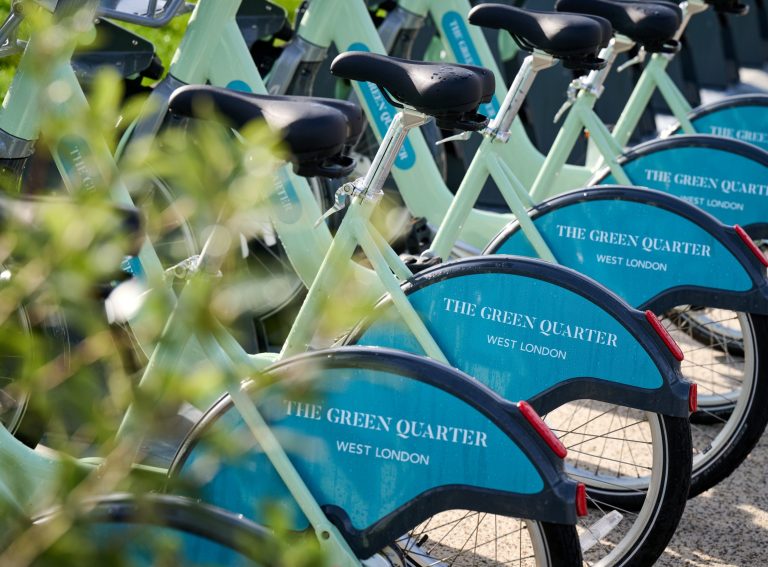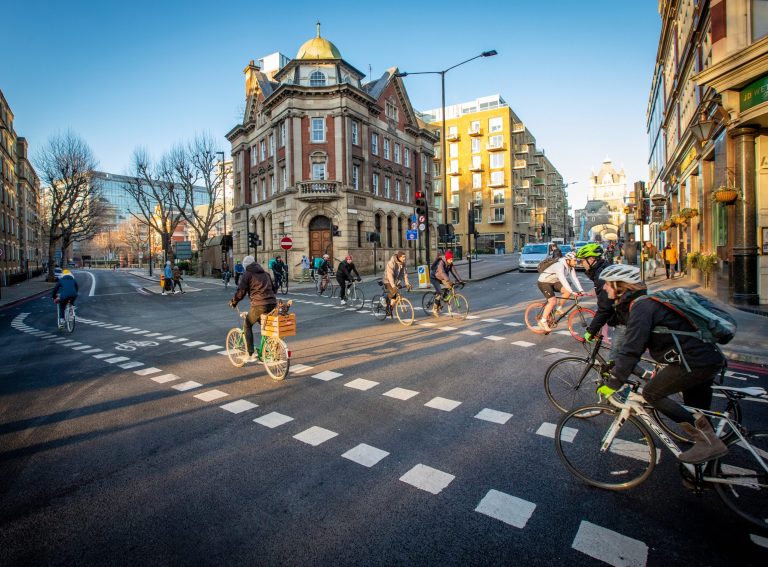Melissa Bruntlett’s journey to becoming an urban mobility advocate began 14 years ago with the decision to sell her family car.
Living in Vancouver at the time, she was constantly being asked how she made cycling work as a main mode of transport with kids who were one and three years old.
Fast forward over a decade and Melissa now lives with her family in the world’s bicycle paradise of the Netherlands. Alongside husband Chris Bruntlett, the pair have published two books which show how healthier, happier, human-scale cities can all come from sustainable transport.
Zag Daily: You wrote your first book, ‘Building the Cycling City: The Dutch Blueprint for Urban Vitality’, before you moved to the Netherlands. What was your inspiration behind it?
Melissa: “We took a family trip to the Netherlands in 2016. As cycling advocates in North America, we often talked of these amazing examples of cycling cities and I needed to truly experience it for myself. We visited five Dutch cities during a five-week trip and partly funded it by writing articles for local newspapers in Vancouver. But we realised we couldn’t tell the story in 1500 words. So we pitched the idea of a book which would examine how the Dutch cycling landscape came to be and how it’s being applied in North American cities. There’s always this argument of ‘that’s Amsterdam, that’s the Netherlands, that’s Copenhagen’ to say that we can’t do it in North America but we wanted to show that yes you can. It’s not going to be a copy and paste solution from the Netherlands, but you can take their inspiration and thought-processes and apply it to New York City, Vancouver, or wherever it might be.”
Zag Daily: What was a key action you found the Netherlands to have taken to make it such a bicycle paradise?
Melissa: “There isn’t one single action. When you look back at the Netherlands in the 1950s and 60s, just like everywhere else, there was rapid investment in the mobility of the future – cars. You had cities widening roads, Utrecht for example burying a canal to build a highway, Amsterdam planning to demolish a Jewish quarter to put in a freeway that travels to the north. The focus was on creating car-centric cities but then the confluence of two events shifted the thinking. The first was that cars were seen as taking over Dutch streets and the second was the OPEC crisis.”
Zag Daily: How did these two events shift Dutch thinking about transport?
Melissa: “With more and more cars entering the streets, a huge road safety crisis began to occur in the Netherlands. Over 3,000 people a year were dying in car crashes and 450 of those were children. Parents, teachers, and those who were genuinely committed to saving lives began the ‘Stop de Kindermoord’ movement which translates to ‘Stop the Child Murder’. You had people protesting in the streets and others laying their bikes out to make a statement to improve road safety for walking and cycling.
“Then the OPEC crisis hit in 1973 and in order to manage fuel shortages the national government set car-free Sundays. This meant no driving was allowed on Sundays in the Netherlands to help preserve the fuel that was available. Suddenly, people took over the streets on their bikes and roller skates and had picnics in the middle of freeways. This sparked the imagination of Dutch people to remember what public space used to be used for. Leaders became more willing to use their political will to shift from car-focused to inclusive transport planning that caters to all the ways people move around.”
Zag Daily: So did these two events impact the Netherlands more than other countries, or was it that the response was greater?
Melissa: “I don’t believe the Netherlands experienced these events more harshly than other countries, though I don’t know for certain. I think it was more about their response. You had political leaders putting their necks on the line to say the country must have safer transport systems. You saw the first traffic circulation plan pop up in Groningen which was spurred by young ambitious leaders who were putting up with death threats to get it started. Trial programmes in The Hague put in cycle streets that were then pulled up in the middle of the night by local businesses. There was a failed example in Tilburg where a cycle lane took you from nowhere to nowhere. Not all of it was a success but all of these actions came together to lead a period of experimentation that eventually led to a real understanding of network planning for cycling. The Netherlands now has 37,000 kilometres of cycle infrastructure across the country.”
Zag Daily: You made the move from Vancouver to the Netherlands in 2019. Why?
Melissa: “We fell in love with the country when we visited three years earlier. Our children were seven and nine on that trip, and it was the first time they experienced ‘freedom’ from us. We could sit on the patio and enjoy a coffee or a beer, and know that they’re safely able to go to and from a very nearby playground. My husband and I enjoyed the pace of life here, but the most important thing for us was that our children had the opportunity to enjoy freedom and autonomy the way Dutch children get to.
“Back in Canada, when our eldest daughter was nearly a teenager, she wanted to be doing all the things that teenagers did like go to the mall and hang out with friends. Even if we gave her that freedom to travel on her own, her peers wouldn’t necessarily have the same freedom from their parents because they’re worried about social safety or traffic safety. Don’t get me wrong, we would have had a very happy life if we had stayed in Vancouver. But we knew this alternative existed where we could give our children the opportunity to truly experience their teen years here with more freedom.”
Zag Daily: This theme of freedom and the impact of cars on sociology and human psychology is explored in your second book ‘Curbing Traffic: The Human Case for Fewer Cars in Our Lives’. Can you tell us more about what you found?
Melissa: “This book was about sharing the mental health impacts of having made the move to the Netherlands where there were fewer cars on the roads. We wanted to ask: why do we feel the way that we do? We looked at the impact that traffic noise, for example, has on our stress levels and found that when you have lower traffic environments, your fight or flight response is reduced. If you’re at a busy corner waiting at a traffic light with cars moving around you, bikes, walkers, and noise, your brain instantly goes into fight or flight mode and tells you you’re in a stressful environment. Even at home, in Vancouver we had about 150,000 cars pass through the four blocks around our house each day but in the Netherlands it’s about 1,500. That decrease in traffic means we actually hear quiet which causes our brain to calm down, and we feel less stressed when we walk out our front doors. We aren’t met with a wall of noise or traffic and we don’t need to move around in this heightened state of ambient stressors causing us to be constantly alert. Instead, you’re met with other people, you hear children playing and the birdsong around you.”
Zag Daily: Does the psychological impact of cars versus cycling go beyond stress?
Melissa: “Yes. Seeing people around you releases oxytocin which is a feel-good hormone that makes us happier. Research shows that while oxytocin can’t cure us from cancer, it’s linked to improved health and means we can recover from illnesses faster. Kids cycling to school independently from the age of eight means they’re having more social interaction and reduced likelihood of depression compared with children who move around in the backseat of a car. I’m trying to summarise 10 chapters of our book, but ultimately the message is that people feel happier in public spaces without cars because we’re social creatures and need to be around other people.”
Zag Daily: The book explores how the knock-on effect of this is a city that’s calming, trusting, child-friendly, feminist and accessible. What impact of cycling on society surprised you the most?
Melissa: “The inclusivity of the city. In the mobility sector, we talk a lot about making cities more inclusive but we often separate the human experience from the technical solutions. We know that creating a wider cycle path means it’s safer and more people will use it, but we usually look at it from the data side. We don’t look at it as often from the qualitative side of people feeling more connected to their community, happier, and safer to let their children roam around independently. In all the research we did for this book, I realised that we can’t separate these two aspects. It was an affirmation that how we feel is just as important as the technical solutions in public space. Because if we don’t feel comfortable or safe then we’re not going to use it.”
Zag Daily: Your third book is set for release next year. Can you give us a teaser?
Melissa: “Absolutely. This book is about understanding what it is about women in leadership roles that help cities rapidly evolve. Paris for example has seen rapid urban mobility transformations, and in Montreal there’ve been leaps and bounds in the last 10 years with Mayor Valérie Plante at the helm. The book isn’t a generic statement to say women always make things better and men don’t – we know so many amazing men doing amazing things. We just really wanted to unpack what it is about women in leadership roles that make room for urban change. What we found is that there are commonalities between the women we interviewed and the cities we profiled when it comes to understanding the qualitative impact of what cities can be and what urban spaces can provide. By no means have we scratched the surface of the number of wonderful women making changes around the world, but I hope it helps inspire the next generation of female leaders to see what is possible and not lose hope that we can achieve a brighter future in every city.”
Zag Daily: Who is one woman in the sustainable transport sector that inspires you?
Melissa: “Fiona Campbell, the Manager of Cycling Strategy at the City of Sydney. She’s been working in the sector for a long time, and doesn’t let the obstacles dissuade her from her passion. Even though Sydney has had its stalls and starts, she’s always so optimistic that it is possible to make change. She’s the kind of person I try to be, because it’s easy to get overwhelmed with what’s happening around the world, but if we can find our peace and keep pushing for what we want then we will move forward.”





